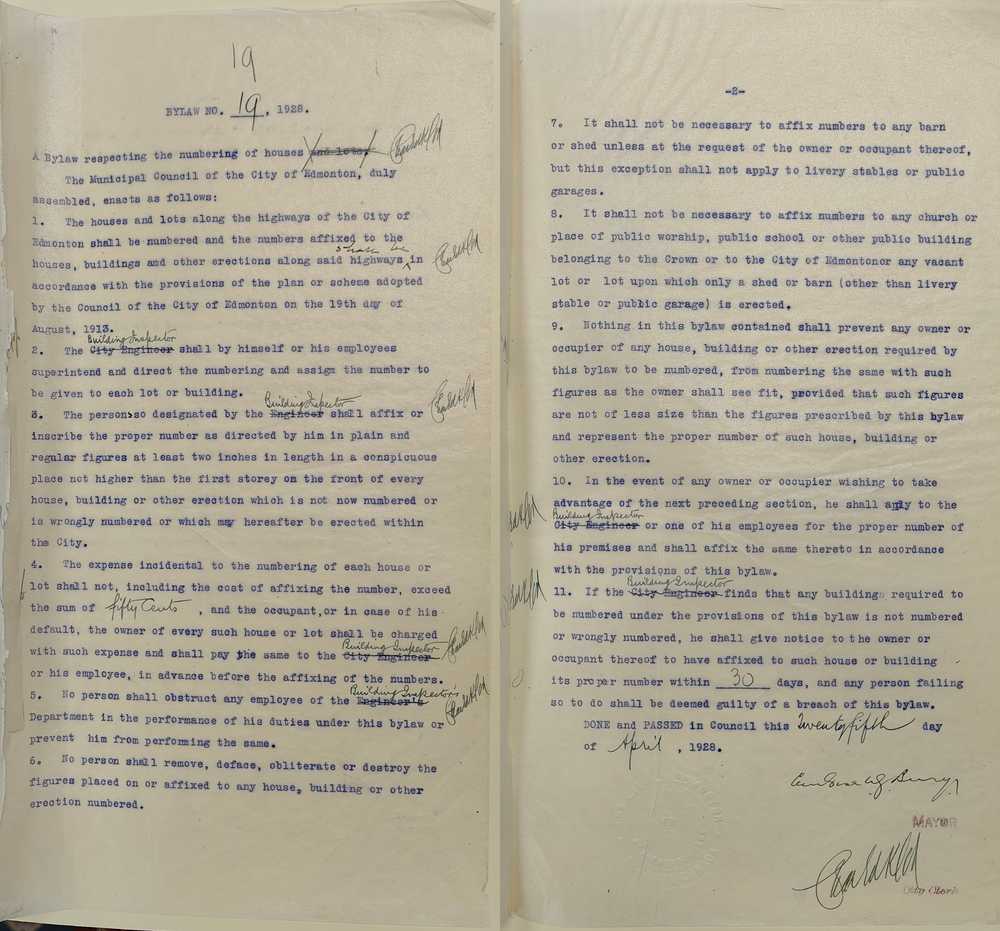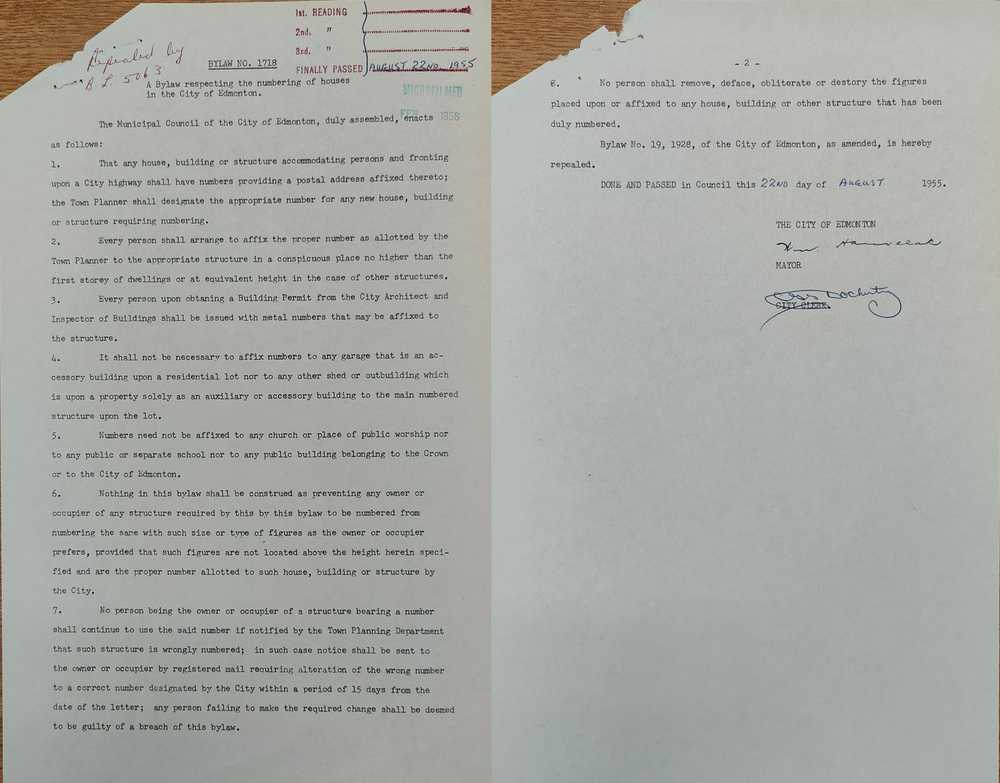Where we last left off, I was walking old neighbourhoods to document historical house number plates in Edmonton. This empirical survey, besides wearing out my legs, had resulted in fifty geo-located photos of original house number plates in situ. Furthermore, going through the tax records for each address suggested a date range between 1914 and the mid-1950s. Not bad for information gleaned solely by walking around!
Enter the City of Edmonton Archives, which hold a large volume of material relating to the inner workings of the city government. How will original period documents relate to the data I've gathered from the streetscape?
Unsealing the vaults
Archivists are wonderful but their discipline is not magic. Before I phoned, I put together a simple little priority list of documents that I hoped could totally reshape what I know about Edmonton house number plates. At the very least, even if nothing else turned up, I was confident that I'd be able to pull a couple Number 3 items.
Priority list
- Original specifications prescribing the form of the typical foil-and-glass Edmonton house number plate.
- Anything related to number plate procurement, most likely involving some local sign shop.
- Original bylaws and city council minutes relating to addressing and house numbering.
When I visited for the first time in early January, I was not surprised to find out that the only documents which the archivists had been able to turn up on my behalf were bylaws and council minutes.
Bingo - we have a hit on February 29th, 1928! (Check it out yourself at 1928 City Council Minutes, Meeting No. 10.)
The minutes read...
- Numbering of Houses.
Recommending that a bylaw be passed requiring owners or occupiers of houses to have the proper number affixed to the front of the house where it can readily be seen from the sidewalk.
MOVED Ald. Farmilo,
That the recommendation be concurred in and the City Solicitor instructed to prepare the necessary bylaw. AGREED
We're off to a good start: the language here strongly implies that this is the first house numbering bylaw in Edmonton's history. This bumps our earliest start date fourteen years into the future from 1914, the year that Edmonton and Strathcona rolled out a uniform addressing system.
Here's what happened on April 25th, 1928, when the full bylaw text was presented to council. (Check it out yourself at 1928 City Council Minutes, Meeting No. 19.)
Bylaws Committee No. 8.
- House Numbering C.R. 10-12
Recommending approval of bylaw as drafted. AGREED
Later that night, the final text was approved unanimously.
So what did the City Solicitor cook up?
Bylaw No. 19, 1928
Among other things:
A Bylaw respecting the numbering of houses.
The Municipal Council of the City of Edmonton, duly assembled, enacts as follows:
- The houses and lots along the highways of the City of Edmonton shall be numbered and the numbers affixed to the houses, buildings, and other erections along said highways shall be in accordance with the provisions of the plan or scheme adopted by the Council of the City of Edmonton on the 19th day of August, 1913.
Off to a good start. We take this requirement for granted today, but if we're really lucky, its relative novelty in 1928 will mean that the bylaw text is more descriptive than its distant successors.
- The Building Inspector shall by himself or his employees superintend and direct the numbering and assign the number to be given to each lot or building.
We have a specific department involved with the day-to-day administration of house numbering! This will come in handy for subsequent visits to the Archives.
- The person so designated by the Building Inspector shall affix or inscribe the proper number as directed by him in plain and regular figures at least two inches in length in a conspicuous place not higher than the first storey on the front of every house, building or other erection which is not now numbered or is wrongly numbered or which may hereafter be erected within the City.
This is not a very detailed spec, but "at least two inches in length" is better than nothing. In practice, from walking the streets, we know that "a conspicuous place" often meant "immediately above the door".
- The expense incidental to the numbering of each house or lot shall not, including the cost of affixing the number, exceed the sum of fifty cents, and the occupant, or in case of his default, the owner of every such house or lot shall be charged with such expense and shall pay the same to the Building Inspector or his employee, in advance before the affixing of the numbers.
Here's what interests me the most about the 1928 bylaw: a price being limited to fifty cents! In order to avoid the usual grumbling that accompanies any novel regulatory change on the planet, I suspect that the City was selling these below cost in order to encourage compliance. It's very difficult to imagine how the City could enforce this provision unless it was directly involved in the manufacture of house number signs.
It's not the perfect smoking gun that I imagined, but I think this is fairly clear proof that these signs are not just widespread because they were being sold by the only hardware store in town. Some public dollars went towards manufacturing and distributing them at an appealingly low rate.
Further paragraphs explain that barns, sheds, churches, places of public worship, public schools, public buildings, and vacant lots are all exempt from needing to display numbers. (Interestingly, you can see one installed on St. Anthony's Catholic Church on Whyte Avenue anyway.)
- Nothing in this bylaw contained shall prevent any owner or occupier of any house, building or other erection required by this bylaw to be numbered, from numbering the same with such figures as the owner shall see fit, provided that such figures are not of less size than the figures prescribed by this bylaw and represent the proper number of such house, building or other erection.
Some very useful proof that standardized numbers were never REQUIRED and you could always go buy them from the hardware store yourself. This calls for a slight rethink of a metric that I was previously calling "survival rate", because it's proof that these glass-and-foil numbers were never installed on EVERY building.
In case you were politely holding yourself back from keeping count, the entire bylaw uses all derivatives of the word "erection" six times.
Edmonton residents may be disappointed to learn that vintage house numbers are NOT available for fifty cents today: this bylaw has long been repealed. So what came after it?
Bylaw No. 1718 (1955)
Dwight Eisenhower is on the throne, and Elizabeth II has just been crowned President. Welcome to the futuristic world of August 22nd, 1955.
Among other things, this updated bylaw shifts jurisdiction over house numbering from the Building Inspector to the Town Planner, probably related to the massive post-war suburbanization and expansion of the civil service we see in all Canadian cities. In pre-war Edmonton neighbourhoods, it's extremely rare to find entire blocks that were all built around the same year. Forget about central planning!
There are two really important words in here:
- Every person upon obtaining a Building Permit from the City Architect and Inspector of Buildings shall be issued with metal numbers that may be affixed to the structure.
Metal NUMBERS, plural. I would not use this language to describe a manufactured glass and foil plate. It sounds to me like the City probably switched over to the interchangeable 0-9 hardware store digits that we know today. Makes sense: by the 1950s, foiled glass was long out of style, and it's entirely possible that a single high-volume City of Edmonton contract was keeping some elderly sign shop employee from retiring.
Bonus: no more language about fifty cents! It sounds like those lucky 1950s homeowners were getting their metal numbers for free.
So do these two bylaws bookend the glass-and-foil number plate era in Edmonton? Even if you don't believe my argument that the phrase "metal numbers" excludes the old glass plates that we see around town, my empirical tax year data (as of this writing) strongly supports SOME kind of cutoff in the middle of the 1950s:
| Decade | Observations |
|---|---|
| 1900s | 3 |
| 1910s | 13 |
| 1920s | 9 |
| 1930s | 14 |
| 1940s | 53 |
| 1950-1955 | 10 |
| 1956 | 1 |
| 1960-date | 4 |
In lieu of anything else turning up in the archives, I think a bylaw change (which, importantly, transferred house numbering authority between two city offices) is the most likely explanation for this sudden drop-off.
Henderson's Directories
I was really excited that these two bylaws seemed to provide unique, new information that constrained my date range to 1928-1955, but if you flip back to my priority list, I was a little disappointed that I failed to uncover any actual contract, invoice, or receipt proving that the City of Edmonton ordered these from a local manufacturer.
There was one more lead accessible in the Archives' reading room: a nearly complete set of Henderson's Directories, a private Internet precedessor which attempted to get every business in town to pay a small annual fee for inclusion. Since I didn't have anything better to do, I decided to record a complete inventory of every sign shop active in Henderson's from 1908 (the earliest year available) to 1955.
This led to a record of the names and addresses of about 70 unique businesses. Most were flashes in the pan, usually a sole proprietor listed by his personal name for a couple years worth of history. Only a few had any kind of lasting presence, and only two operated through our entire period of interest, 1928-1955.
| Company | Years active |
|---|---|
| Hook Signs Ltd. | 1912 - 1955 |
| Kitchener Sign Co. | 1912 - 1927 |
| Henderson Signs Ltd. | 1914 - 1939 |
| Law Bros. | 1920 - 1942 |
| Commercial Signs Ltd. | 1921 - 1955 |
| Capital City Signs | 1924 - 1953 |
This is already promising. Rather than looking for all possible City of Edmonton dealings with any sign shop, we can just look for all possible City of Edmonton dealings with Hook and Commercial... and keep our eye out for any appearance of the other, smaller companies, too (no reason why some of the plates couldn't have been done by a random low bidder in some years). The Archives have done a pretty good job of uploading machine-searchable finding aids to their website, so having specific business names makes searching from home much easier.
Even better - against all odds, Hook DONATED ALL THEIR STUFF TO THE CITY ARCHIVES when they got bought out in 1981!!! It's never going to happen again in my entire life that the weird defunct company I'm researching just so happens to have done this, so I'll enjoy it now.
You can check out the Hook Signs Ltd. fonds here, perhaps most notable for containing 2,000 photographs of random mid-20th-century Edmonton streetscapes. The OK Construction building seems to have a tiny original house number plate in its usual location right above the door:
I looked through about half of these photos and didn't find anything incredibly relevant to my query. If Hook was getting the City house number contract, their cameraperson didn't particularly care about documenting it, instead concentrating on the distinctive billboard installations that the company probably spent much more of its time and money on.
I also enjoyed how many unidentified street intersections were photographed in their raw natural form, before any billboards were ever installed. Market research!
That's all for today
We've uncovered a lot more information about old number plates in Edmonton, but this was just one visit to the Archives: pulling all those nice searchable company names, in particular, has given me more tools that I can use to attempt to track down those pesky sign-making documents that I think must have existed at one time.
-
On my next Archive visit, I'll be asking to see both archived copies of a 1930s municipal building code, issued by the same Building Inspector who was responsible for house number compliance at the time. If there is any surviving technical specification explaining how these number plates should be manufactured, I suspect it may exist in here.
-
Having access to all recorded City of Edmonton contracts AND a selection of Hook Signs Ltd. records will allow me to go to sleep easy thinking that I did my best to hunt down some kind of commercial transaction record.
Until then - it's a start, and there are always more streets to walk!!




